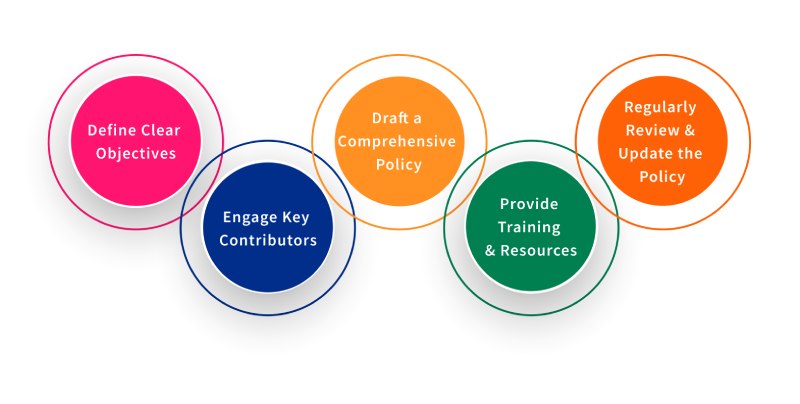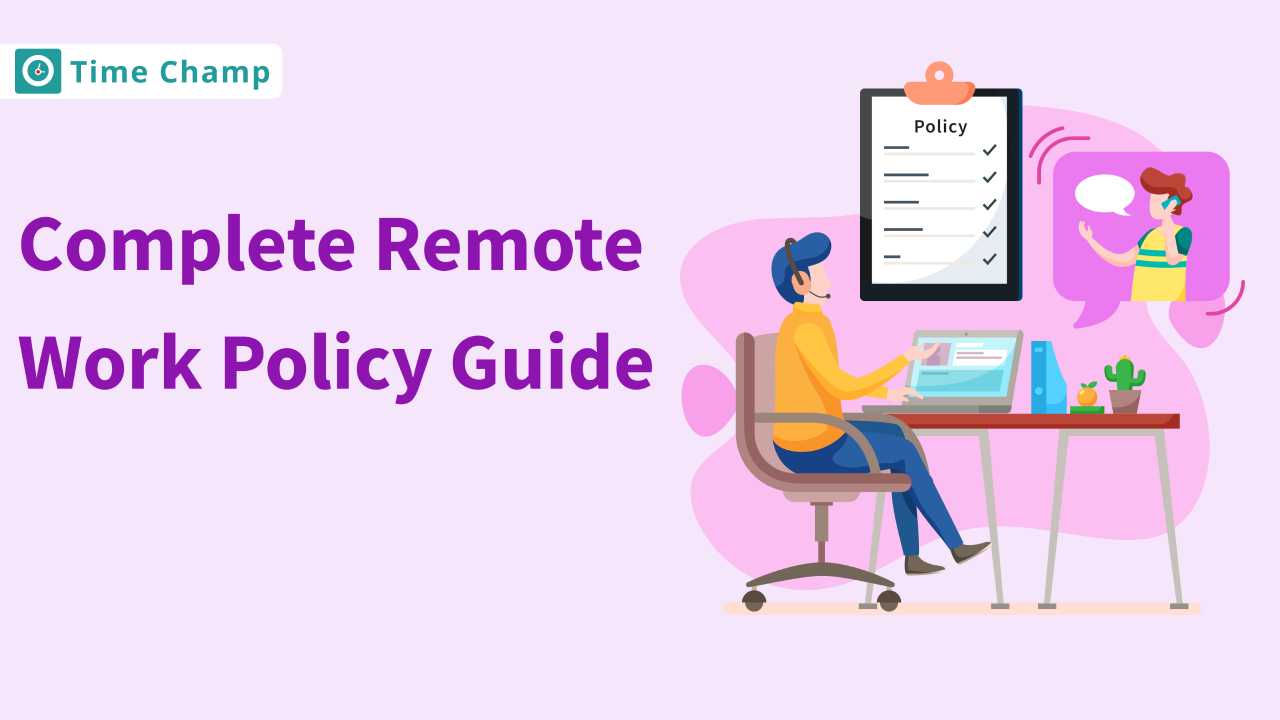Creating a remote work policy is crucial for keeping your team on track and ensuring smooth operations, especially when working outside the office. In this blog, you will find everything you need to set up a clear and effective remote work policy for your company. If you are new to managing remote teams or just want to improve your current structure, this guide will help you to navigate the main components of a policy that sets expectations, maintains productivity, and keeps everyone connected. You will get a completely ready-to-use template, which you can simply adjust according to your company’s unique structure, practices, and requirements.
What is a Remote Work Policy?
A remote work policy is a clear set of guidelines that outline how your team should work when they are not in the office. It outlines everything from who is eligible to work remotely, what equipment they need, how to communicate effectively, and how their overall performance will be tracked. In a nutshell, it will help you set expectations for your employees and thereby ensure that everyone is on the same page. Having a remote work policy in place helps you ensure that your team remains productive, connected, and accountable, no matter where they are working from.
Why is Having a Remote Work Policy Essential for Your Company’s Success?
A clear remote work policy is very important for the success of your company, as it sets expectations with your team, assisting everyone in understanding their roles and responsibilities while working remotely. This clarity boosts productivity, as employees are well aware of what is expected of them, and it also promotes accountability by making it easier to measure performance and ensure tasks are completed on time.
Furthermore, a remote work policy increases employee satisfaction by showing that you care about your team’s needs and work-life balance. While satisfied employees are typically more engaged and motivated towards work, this leads to better outcomes for your company. Overall, a solid remote work policy becomes an essential resource tool supporting your team’s success and fueling growth for your company.
How to Create an Effective Remote Work Policy?

Here are the essential steps needed to develop an effective remote work policy.
1. Define Remote Work:
Begin by stating what remote work means for your organization. Can employees work from home completely of the time, part of the time, or certain days of the week? You should also specify what types of remote work are allowed, like working from home, using co-working spaces, or doing work from a different time zone. Make sure this matches with your company’s goals and values.
Also, clarify if remote work is a temporary setup like during a pandemic, or an available option for the long term. This sets clear expectations and avoids confusion at all costs in the initial stages.
2. Identify Eligible Roles:
It is important to determine which roles can be done remotely. You need to consider the tasks and responsibilities of each role. Some jobs cannot be done from home because they require face-to-face collaboration or using special equipment that can’t be used from home. However, for administrative, IT, or creative work, many tasks can be done extremely well remotely.
Team Collaboration: Consider how much the role depends on teamwork. If considerable teamwork is involved, identify if online tools can replace in-person interactions while still maintaining efficiency without needing physical presence.
Client Interaction: If the role involves regular client meetings, decide whether video calls are enough or in-person meetings are required.
The clear definition of rules for people working from home ensures both you and your team know why some roles can be done outside the office while others cannot.
3. Set Clear Expectations:
Establishing clear expectations is crucial for a successful remote work policy. Determine what you expect from your employees concerning working hours, availability, and performance. Convey the values and obligations of being mindful of the team collaboration and staying on top of productivity, even working from home. You may even want to define some KPIs for them to work toward. By establishing these standards from the start, you are providing the guidance your team needs in order to succeed in this environment and avoiding any possible future problems or misunderstandings.
4. Address Compensation and Benefits:
In developing a remote work policy, compensation and benefits should be considered as well. Ensure what aspects of salary, bonuses, and other benefits will be impacted by working from home. Determine if home-based workers can enjoy all the benefits on par with office-bound workers or not as they are working remotely. The additional expenses like setting up a home office or internet bills, among others, that remote workers may have to incur should also be considered. It, therefore, clarifies all the points so that all members of the company understand their compensation and benefits, thus instilling fairness and trust among the team.
5. Provide Equipment Guidelines:
Setting clear guidelines about equipment is vital in the successful operation of remote work. Inform your employees about the tools and technology required to do their jobs at home. Will the company provide laptops, software, or any other equipment? If they are going to use their own equipment, define what is acceptable. In addition, put clear rules about maintaining the equipment, remote work security measures, and solving any technical issues that may arise. Clearly instructing your team on how to use the equipment will give them a smooth working experience without extra problems.
6. Outline Performance Measurement:
It is essential to have a way for measuring performance while working from a remote location. Define how you will measure productivity and effectiveness, noting the challenges that come with working remotely. You might use regular check-ins, performance reviews, and feedback sessions for assessing the employees’ work. Define clear goals that align with your business objectives, and that your team understands. Measuring your performance transparently will serve to help the employees see how all work helps the firm achieve success while, at the same time, allowing them to provide feedback and identify areas needing improvement.
7. Communicate Data Security Measures:
When employees work from home, data security is pretty crucial. Explain to them the security measures that everyone should follow by everyone to protect sensitive information. This includes using VPNs, creating strong passwords, and updating software regularly. Educate your team on why data privacy matters and the risks associated with working remotely. By sharing these guidelines, you build a culture of security awareness to help all the team members take the right steps to keep company data safe.
8. Create a Communication Plan
An effective communication plan is critical to the success of remote work. Ensure the method and schedules through which your team must communicate; it could be video calls, instant messaging, or emails. Schedule regular meetings to keep everyone on the same page and provide opportunities for individual members to update themselves on each other. Open communication leads to cooperation among the employees and brings all of them in, regardless of where they are working. The clear strategy of communication will help keep cohesion among the teams while fostering a collaborative work environment.
9. Review and Revise the Policy Regularly
Lastly, you should review and update your policy on remote work regularly. Your policies should always evolve just as the nature of work and technology evolves. Set a schedule for regular reviews and assessments to gather feedback from your team to recognize areas that need improvement. Don’t hesitate to change your policy if it is influenced by current situations or by employees’ needs. This method proves to your team that you highly value their input and are committed to maintaining a supportive remote working environment.
By following these practices you can create an effective remote work policy that not only assists your team but also improves productivity.
Remote Work Policy Template:
Purpose
This Remote Work Policy sets very clear guidelines and expectations for employees working from home to ensure productivity, effective communication, working together efficiently, and creating a supportive environment for everybody.
Scope
This policy applies to all employees who have been authorized to work remotely on a full time, part time or occasional basis.
Eligibility
The nature of the job must lend itself to remote work without sacrificing productivity.
The employee needs a proven record of satisfactory performance and the ability to work independently.
Authorization for telework needs to be at the discretion of the employee’s immediate supervisor or manager based on individual circumstances.
Work Hours
Employees are expected to work during the standard operating hours of the company, except where otherwise agreed between the employees and managers.
Employees may, subject to approval from the concerned manager, be granted flexibility in the observation of working hours.
Employees must accurately record their hours of work, break time, and overtime worked through the company’s time-tracking system.
Communication
Employees should be accessible through emails, phone calls, or messaging apps during their work hours.
Employees should meet up once a week or every two weeks with either the manager or team members to discuss project progress and point out issues that they are experiencing.
Managers encourage video calls and project management software among employees, providing better communication channels between them.
Equipment and Technology
The company will provide all the necessary equipment, including laptops, software, and other resources required to be able to work remotely.
Subject to receiving permission from the company, employees are allowed to use their own devices in the workplace only if the said devices meet the security standards laid down by the company.
Employees must ensure they have a reliable and secure internet connection in their home workspace.
Performance and Accountability
They should maintain their productivity at the same levels they would have if they were on site.
Regular performance reviews will be conducted to ensure how well remote work is going, and feedback will be given to improve continuously.
Employees need to work with their managers to set clear and measurable goals for their remote work tasks.
Confidentiality and Data Security
Employees must observe secrecy regarding sensitive information through company rules and regulations.
Employees must follow data handling principles set by the company. This involves data filing, passwords, and document destruction.
Health and Safety
Employees are encouraged to promote a safe and ergonomic working environment that minimizes health impacts attributed to the long-term use of computers.
All work-related injuries and hazards happening at their home workspace must be reported immediately to a manager by employees.
Policy Review
This policy will be reviewed annually and updated where necessary to reflect changes in the work environment, technology, and legal requirements. Any significant changes to this policy are communicated to employees.
Acknowledgment
All employees are required to sign an acknowledgment form confirming that they have read, understood, and agreed to abide by the remote work policy. This acknowledgment will be maintained in the employee’s personnel file.
Best Practices for Implementing a Remote Work Policy

Following are some of the best practices for implementing a remote work policy.
1. Define Clear Objectives
First, define your goal in establishing your remote work policy. What are your desired outcomes? Do you want to improve productivity, enhance employee satisfaction, or accomplish better work-life balance? Share those goals clearly with your team. Once people know the purpose, they can align their work more effectively with the vision of your company.
2. Engage Key Contributors
Involve your staff and other stakeholders at the setup of the policy, by soliciting their thoughts and listening to their concerns. This engagement process will not only help you acquire appropriate information but also displays the employees that they are valued in the decision-making process. When they have a say in the policy, they will be more likely to back it and embrace it.
3. Draft a Comprehensive Policy
Create a comprehensive remote work policy detailing expectations, guidelines, and procedures. Clearly define your working hours, communication channels, and performance metrics. A comprehensive policy spells out what your team needs to know, eliminating confusion because everyone will be informed about the same thing. As well, it should be understandable and accessible to everyone.
4. Provide Training and Resources
Once you have developed your policy, train your team to apply the policy correctly. Provide them with the necessary tools and resources – be it good software or technology support. Training allows your team to know how to adapt to the policy and use the tools available, thus resulting in a smoother transition into a remote work environment.
5. Regularly Review and Update the Policy
Your remote work policy should be a living document. The only way to know whether it’s working well or not is to get input from the team. Are there issues that need to be addressed? Is it meeting the set goals? Keep an open mind about adjusting based on insights from their experiences and on changes in the work environment. Flexibility shows commitment to continuous improvement and keeps your team engaged and productive.
Common Types of Remote Work Policies
Some of the common types of remote work policies.
1. Flexible Remote Work Policy
With a flexible remote work policy, you allow your employees to choose their own work hours and location. This policy encourages a much healthier work-life balance and helps your team to manage their time effectively. By trusting them to get the job done, you create a positive atmosphere that fosters engagement and productivity.
2. Set Schedule Policy
A set schedule policy assigns specific work hours to your remote team. Employees are expected to be available during these hours, ensuring clear communication and collaboration. This structure maintains a routine that keeps your team coordinated.
3. Results-Only Work Environment (ROWE)
In a results-only work environment, it is about the outcome rather than the number of hours worked. The team is free to work from wherever and whenever they want as long as the goals are achieved. This policy encourages employees to work independently and moves them toward being motivated and creative.
4. Occasional Remote Work Policy
An infrequent telecommuting policy allows employees to work from home as required, for instance, to attend to personal commitments or work on special projects. This type of flexibility allows your team to adapt according to certain circumstances while staying in touch with the office for immediate needs. It strikes a workable balance between in-office collaboration and personal needs.
Also Read: Hybrid Work Policy: Top 7 Tips to Create it Effectively
Conclusion
A good remote work policy is the first step toward helping your team be successful while working from home. It sets clear expectations, keeps everyone accountable, and ensures that all communication goes smoothly, regardless of where your employees are located. By following the best practices and the template, you will be guided to create a well-tailored, company-specific policy that can help foster productivity. Remember, your policy has got to evolve with feedback from your team and the changes in work dynamics, ensuring that everyone can work positively and efficiently from home.
Optimize your remote work environment and achieve greater productivity with Time Champ!
Signup for FreeBook DemoFrequently Asked Questions
A remote work policy describes a set of guidelines outlining how employees are expected to function when working at locations outside the traditional office. These include eligibility requirements, communication expectations, data security measures, and equipment required to ensure productive, secure, and goal-aligned work.
A clear remote work policy in the workplace keeps everyone well informed about expectations for working remotely, maintaining productivity, accountability performance, and employee satisfaction. By setting clear guidelines, it prevents misunderstandings, supports team collaboration and creates a framework for measuring performance and protecting data.
Regular check-ins, KPI goals, and some sort of project management tools can help you to monitor your employees’ performance. Clear, measurable goals should be set with regular reviews, so you can track whether employees are meeting expectations and identify areas for improvement.
Implement security measures such as VPNs, strong passwords, two-factor authentication, and software updates. Educate employees on the best ways to protect data and how confidentiality impacts their jobs, even outside the office, to set a safety barrier against particular risks involved with remote work.
The remote work policy must be reviewed and make changes to policy annually, as well as whenever there are any other material changes in its terms, through changes in the dynamics of work, technology, or employee feedback. Regular review ensures that the policy remains effective and relevant to the needs of both the organization and its employees.







